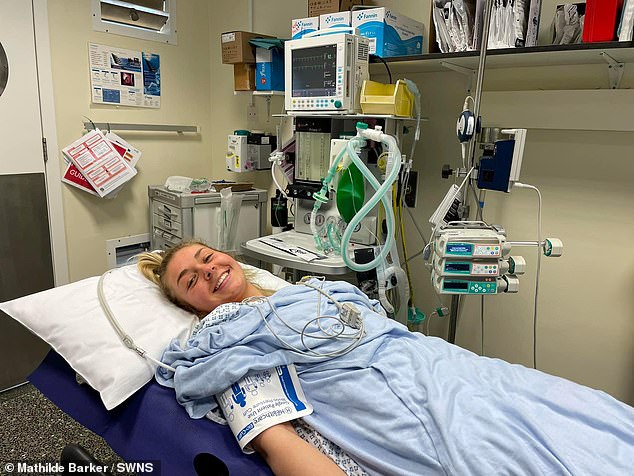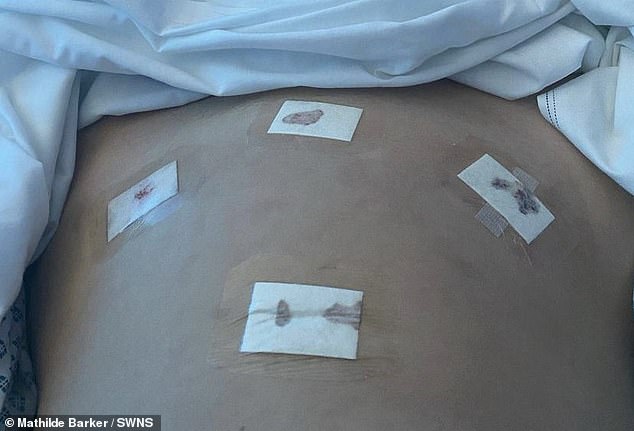Doctors told me period cramps that felt like contractions were normal and called me dramatic – it took 5 years to be diagnosed with stage 4 endometriosis
A woman diagnosed with stage four endometriosis said her cramps became so painful they felt like ‘contractions’ – but a doctor said the pain was ‘normal’.
Mathilde Barker, 20, from York, North Yorkshire, said doctors ignored her cries for help for five years and labeled her names as ‘dramatic’.
Endometriosis is an often painful condition in which tissue similar to the uterine lining – the endometrium – grows outside the uterus.
Mathilde, a musical theater student at Laine Theater Arts in Surrey, developed back pain at the age of 15, just a few years after her period started. Her symptoms quickly escalated to include painful menstrual cramps that felt like pregnancy contractions.
She traveled back and forth between specialists desperate for answers to her ailment, but doctors were left stumped. That is until April this year, when surgery revealed abnormalities in the back of her pelvis – leading to an immediate diagnosis of stage four endometriosis.
Mathilde Barker, 20, from North Yorkshire, was diagnosed with stage four endometriosis after experiencing painful cramps that felt like ‘contractions’. She is pictured here in the hospital

She suffers from endometriosis, an often painful condition in which tissue similar to the uterine lining – the endometrium – grows outside the uterus (Mathilde in the photo before the diagnosis)
Calling the diagnosis a “relief,” she explained, “They (the doctors) just thought I was being dramatic.
‘They thought it was depression I was developing, but my cramps felt like contractions.
If childbirth is that painful, I don’t want to experience it. The diagnosis was a great relief. It can’t stop me now.”
In addition to muscle pain and painful cramps, Mathilde also experienced loss of appetite, light-headedness, dizziness and nausea.
She decided it was time to see a doctor after experiencing severe back pain after a dance show.
She said: ‘After a dance show I was in so much pain. I thought I had done my back.
‘They told me it was a muscle strain and that I would get better in a few weeks.
“But it became a problem because I was now dancing full-time.”

The student said doctors ignored her cries for help for five years and labeled her names as “dramatic.” (She is pictured in hospital for surgery)

Mathilde is currently studying musical theater at Laine Theater Arts in Surrey, where she is currently pictured

Mathilde traveled back and forth between specialists who were desperate for answers to her ailment, but the doctors arrived dumbfounded (here she is pictured on holiday)
As Mathilde’s pain continued, she was invited to see an osteopath, who diagnosed her with a sprained sacroiliac joint.
The sacroiliac joints are the joints where the lower part of the spine (sacrum) connects to the pelvis. For this purpose, she visited a physiotherapist occasionally for two years, but the pain did not disappear.
After another bout of severe pain, she ended up in the emergency room, where she was again told it was anything but her period, and given antidepressants.
She also tried the birth control pill for the pain, but found her mental health going into a downward spiral and quickly coming out of it.
The back and forth lasted a whopping five years, with Mathilde being told by doctors that the pain was ‘normal’ for a ‘woman’, and even being sent to cognitive behavioral therapy due to medical anxiety:

After much back and forth her luck changed when she was referred for an ultrasound and MRI scan (Mathilde pictured in hospital)

She has remained positive throughout her ordeal, adding: ‘The diagnosis was a great relief. It can’t stop me now.” Mathilde is pictured next to her mother in the hospital

She is now fitted with a Mirena coil – a progestin hormone released in the uterus – to relieve her symptoms and promote fertility. (She is pictured here having fun in class)
“I did three sessions of it and thought, this isn’t right,” she said.
‘I discovered that the pain started before my period came.
‘They said it was normal for women and prescribed me painkillers.
‘I started to get quite frustrated. I endured the pain.”
Her luck changed when she was later referred for a referral that led to an ultrasound and MRI (Magnetic Resonance Imaging) scan.
Although the tests turned up nothing, she was told she needed to have surgery to see if she had endometriosis.
Six months later, in April 2023, Mathilde underwent a four-hour operation at Epsom General Hospital, Surrey, where doctors discovered endometriosis in the back of her pelvis.
She was finally diagnosed with stage four endometriosis and offered a way to ease the pain – through an IUD.
She has been fitted with a Mirena coil – a progestin hormone released in the uterus – to relieve her symptoms and promote fertility.
She recalled the moment she burst into “tears” when she received news of the diagnosis. She explained: ‘They found stage four of endometriosis – the most serious stage.
‘It was all the way around the back of my pelvis. It was a great relief. It was real pain.
‘I burst into tears when they said they had found it. It was a reason for all the pain.”
Since the operation, Mathilde has had less pain, but still experiences the same intensity of pain.
Giving advice to others, she added: “Go into it with a strong will.
‘You are the one who feels what you feel. Don’t let anyone tell you there is no pain.’
